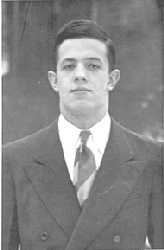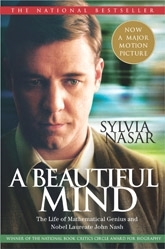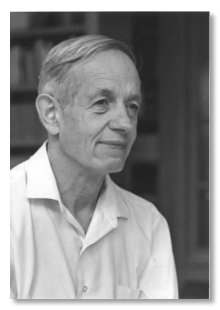 |
| (http://www.princeton.edu/mudd/news/faq/topics/nash ()) |
"'The triumph is that his mind, his soul, his spirit, his intelligence, all of that survived against the will of the madness of schizophrenia. He was still able to engage.'" -Brian Grazer (A Portrait of Shattered Brilliance Comes Together). Grazer, producer of John Nash's movie, A Beautiful Mind, perfectly described how Nash, a remarkable mathematician, portrays acts of heroism through his strength of character in two sentences. John Nash was born on June 13, 1928 in Bluefield, West Virginia where he grew up and attended high school. After he graduated, he attended Carnegie Institute of Technology (later Carnegie Mellon University) for undergraduate and Princeton University for his graduate work. It was at Princeton where he developed the Nash Equilibrium, one of the most influential ideas of the century. Nash completed his Ph.D. in mathematics in 1950, when he was only 22 and later took a job at the Massachusetts Institute of Technology (M.I.T.) in Cambridge, Massachusetts. In 1959, he was diagnosed with schizophrenia, a mental disease characterized by persistent, complex, and compelling delusions that constitute a dramatic rejection of consensual reality. During his "lost years", the time when he was sick, his theory impacted many fields outside of mathematics. He was able to overcome schizophrenia in the late 1980s and started to continue his research once again. Much to his surprise, he won the Nobel Prize in 1994 in Economics for his work in the game theory after his recovery. He was oblivious to the fact that while he was ill, his equilibrium theory helped economists make many important discoveries and came back to the attention of the world with the title of Nobel Prize winner. Despite everything he went through, he was still able to become a success and make a difference through his work. Alive at the age of eighty four, he is working in an office at Princeton where he continues to study mathematics. Nash's work in the game theory was a result of his intellect: the ability to use his mind in ways others cannot to analyze and solve problems. His strength of character helped him withstand the difficulties of a mental disorder, and his determination gave him the motivation to never give up on his work. John Nash, a renowned Nobel Prize winner, was a mathematical genius who overcame multiple hardships in life by utilizing his cunning intelligence, willful strength, and perpetual perseverance.
Nash displayed his intellectual ability all throughout his lifetime, from his time in high school to his battle with schizophrenia; he was a genius from the start, and his fellow colleagues recognized it as well. For example, one of his classmates in high school recalls: "Once his geometry teacher put a theorem up on the board and told the class that it had one solution. 'Oh no, Miss McDowell,' said Nash. 'There are three.' He was right. His teacher was amazed at his ability to assess and solve a problem, doing all the calculations in his head" (Biography Today). He found solutions to even the most difficult of problems in ways normal people could not, displaying that his brain functions differently from others. Even so long ago it was obvious that he would become someone who would make a huge difference through his work and research, and he proved that he had the potential to do extraordinary things in the future. Because of his intelligence, he was able to get into one of the most famous and prestigious schools of all time. As written in the article, "A Portrait of Shattered Brilliance Comes Together": "He entered Princeton with a one-line recommendation from his college adviser: 'This man is a genius.' Within 14 months, he had produced the Nash Equilibrium, the paper on game theory that won him the Nobel in economic science almost half a century later". Being accepted into an eminent Ivy League school like Princeton is extremely difficult, but procuring a scholarship from one is nearly impossible. Everyone predicted that he was a person who would create a phenomenal idea worthy of recognition. However, it was not acknowledgement he was seeking, but for that sense of accomplishment. He wanted to retire knowing that he was successful in helping the world move forward. His equilibrium theory didn't just influence mathematics, but other fields: "development of strategy for modern warfare, governmental science (including political campaigns and lobbying efforts), and business strategy" (Science and Its Times). He exhibited his brilliance all through his life. Yet, it was not only his intellectual ability that caused him to become one the most distinguished mathematicians, but also his moral strength and his motivation to become a success and help his country to reach new heights.
 |
| (http://www.sylvianasar.com/a-beautiful-mind/ ()) |
In addition to his development of the Nash Equilibrium, he also possessed incredible strength. During his time fighting schizophrenia, Nash attempted to avoid being hospitalized. He refused to take medication resulting in many forced hospitalizations. His obstinacy aided in his effort in renouncing the illusions single-handedly. "He was able to overcome schizophrenia. In the late 1980s, slowly and miraculously, Nash began to emerge from the grip of schizophrenia. It is almost a miracle that he was able to overcome this debilitating mental illness; fewer than one in ten sufferers ever truly recover, and rarely without the help of antipsychotic drugs" (Biography Today). One must have a great deal of drive and persistence to conquer a mental disease. He felt the need to continue with his career in mathematics but did not want the aid of medication, thinking that the drugs were overrated, and did not want to experience the bad side effects. Nash accomplished what seemed to be unthinkable at that time; to beat an illness is extremely difficult, but to do it by oneself is amazing. Nash believed it a waste of time to have faith in illusions. His autobiography states: "Thus further time passed. Then gradually he began to intellectually reject some of the delusionally influenced lines of thinking which had been characteristic of his orientation. This began, most recognizably, with the rejection of politically-oriented thinking as essentially a hopeless waste of intellectual effort". His resolve gave him the ability to reject the schizophrenic thoughts. The delusions went from important opinions to a foolish waste of time. Because of his efforts, he was able to continue his research and become a success. During his years battling schizophrenia, his work on game theory helped many to "understand how decision-making works in many fields, from government to labor relations to business" (Biography Today). Since Nash had a relatively uncommon disease, recovery was not so easily obtained. Nonetheless, he proved that nothing is impossible. He illustrated strength and worked through all his hardships in triumph.
John Nash also had the drive to learn and succeed in all he did; he felt the need to figure out everything for himself. John Milnor, one of Nash's colleagues at Princeton, remembered that Nash had: "A profound dislike for merely absorbing knowledge and a strong compulsion to learn by doing is one of the most reliable signs of a genius...He was obsessed with learning from scratch. Milnor recalled: 'It was as if he wanted to rediscover, for himself, three hundred years of mathematics'" (Nasar 69). This reveals how Nash was independent and wanted to form his own way of solving mathematical problems. Also, he felt that not discovering things for himself and acquiring second hand knowledge would "stifle creativity and originality" (Nasar 68), and he "was determined to keep his intellectual independence" (Nasar 71). Furthermore, he never gave up on his research even through his struggle with schizophrenia. "The brilliance of Nash's work was obscured by a three-decade-long battle with paranoid schizophrenia. Despite frequent hospitalizations and the sometimes debilitating symptoms of his illness, Nash continued his work whenever able" ("John Forbes Nash." Science and Its Times). He never ceased his work and pushed through his difficulties. He was compelled to find something worthwhile that would help make a difference in the global community. Nash was intent on continuing his research because he wanted to think of himself as "actively engaged in research and not just resting on his laurels" (Nasar 382). His desire "to achieve something of value through current studies or with any new ideas" (John F. Nash, Jr. - Autobiography) demonstrate his motivation despite all the obstacles he faced. His prodigious perseverance combined with his determination make him a genuine hero.
 |
| (http://www.math.uab.edu/Nash.html ()) |
John Nash also had the drive to learn and succeed in all he did; he felt the need to figure out everything for himself. John Milnor, one of Nash's colleagues at Princeton, remembered that Nash had: "A profound dislike for merely absorbing knowledge and a strong compulsion to learn by doing is one of the most reliable signs of a genius...He was obsessed with learning from scratch. Milnor recalled: 'It was as if he wanted to rediscover, for himself, three hundred years of mathematics'" (Nasar 69). This reveals how Nash was independent and wanted to form his own way of solving mathematical problems. Also, he felt that not discovering things for himself and acquiring second hand knowledge would "stifle creativity and originality" (Nasar 68), and he "was determined to keep his intellectual independence" (Nasar 71). Furthermore, he never gave up on his research even through his struggle with schizophrenia. "The brilliance of Nash's work was obscured by a three-decade-long battle with paranoid schizophrenia. Despite frequent hospitalizations and the sometimes debilitating symptoms of his illness, Nash continued his work whenever able" ("John Forbes Nash." Science and Its Times). He never ceased his work and pushed through his difficulties. He was compelled to find something worthwhile that would help make a difference in the global community. Nash was intent on continuing his research because he wanted to think of himself as "actively engaged in research and not just resting on his laurels" (Nasar 382). His desire "to achieve something of value through current studies or with any new ideas" (John F. Nash, Jr. - Autobiography) demonstrate his motivation despite all the obstacles he faced. His prodigious perseverance combined with his determination make him a genuine hero.
Darnton, Nina. "A Portrait of Shattered Brilliance Comes Together." New York Times 3 June 2001: AR13. Gale Biography In Context. Web. 5 Dec. 2012.
"John F. Nash, Jr. - Autobiography". Nobelprize.org. 10 Dec 2012 http://www.nobelprize.org/nobel_prizes/economics/laureates/1994/nash-autobio.html
"John Forbes Nash, Jr." John Forbes Nash, Jr. (Biography Today) (2010): 1. Biography Reference Center. Web. 4 Dec. 2012.
"John Forbes Nash." Science and Its Times. Ed. Neil Schlager and Josh Lauer. Vol. 7. Detroit: Gale, 2000. Gale Biography In Context. Web. 5 Dec. 2012.
Nasar, Sylvia. A Beautiful Mind. New York, NY: Simon & Schuster, 1998. Print.
Page created on 1/10/2013 12:00:00 AM
Last edited 8/2/2018 11:49:56 PM
